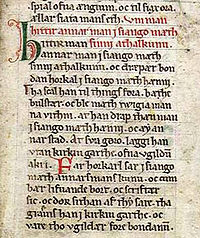- Norse law
-
The Norse laws were originally memorized by the lawspeakers, but after the end of the Viking Age they were committed to writing. Initially they were geographically limited to minor jurisdictions (lögsögur), and the Bjarkey laws concerned various merchant towns, but later there were laws that applied to entire Scandinavian kingdoms.
The court assembly, the thing, used the law and heard witnesses to rule whether the accused was guilty or not. There were usually two types of punishment: outlawing and fines. In rare cases the accused could also be sentenced to death. The most common means of justice were however fines; the amount varied depending on the severity of the offense.
Contents
Iceland
In 1117 the Althingi decided that all the laws should be written down and this was accomplished at Hafliði Másson's farm over that winter and published the following year. The resulting codex is known as the Gray Goose Laws (Icelandic: Grágás) and they were a collection of laws from the Icelandic Commonwealth period consisting of Icelandic civil laws and the laws governing the Christian church in Iceland.
Denmark
Medieval Denmark was divided into three jurisdictions each ruled by its own provincial law; the Scanian Law used in the Scanian lands, the Zealandic Law used in Zealand and Lolland, and the Jutlandic Law used in Jutland (both North and South) and Funen. The Scanian lands were Danish until the middle of the 17th century, and the Scanian Law predates Sweden's similar provincial laws. It was written down around 1200 and exists in several law manuscripts. The earliest extant manuscript, SKB B74 was created between 1225-1275 and is now housed at the Swedish Royal Library. Another copy, the Codex Runicus, was written entirely in runic lettering around 1300 and is now held at the Arnamagnæan Institute at the University of Copenhagen. These manuscripts are however copies of older lawtexts and the Scanian Law is thus counted as one of the oldest provincial laws in the Nordic countries.
All three provinsial laws were given by king Valdemar the Victorious. The youngest of the three, the Jutlandic Law, was given in 1241.[1] Zealand was later given two additional laws: King Eric's Zealandic Law and the Zealandic ecclesiastical law. It is remains unclear which king Eric the former law refers to.
The three laws were replaced in 1683 by King Christian V's Danish Law but as this law was never introduced in Schleswig, the Jutlandic Law remained in force for this jurisdiction. The oldest known copy of the Jutlandic Law, Codex Holmiensis 37 is currently owned by the Swedish Royal Library. Recent research has rejected earlier claims that described this copy as Swedish war booty from 1657-60 wars, as the book appears to have been in Danish ownership during the early 18th century.
Swedish provincial laws
The Swedish provincial laws(in Swedish landskapslag) were the means of law holding in Sweden during the Middle Ages. The provinces of Sweden, or landskap were practically separate countries and had individual laws.
Provincial laws are known to have existed in the provinces of Västergötland, Östergötland, Dalarna, Hälsingland, Södermanland, Uppland, Västmanland, Värmland and Närke. A provincial law also existed for Gotland, Gutalagen.
In older times the laws were memorized by a lawspeaker (lagman). Around 1200 the laws began to be transferred to written form. This was probably due to clerical influences.
The oldest of the Swedish provincial laws is the Westrogothic law or Västgötalagen, which was used in the province of Västergötland, in west Sweden. Like Gutalagen, it was written in its oldest version around 1220. Some regulations are likely to have their origins in the Viking Age. A stipulation that "no man may inherit while he sits in Greece", for instance, would have been useful during the Viking Age when many Swedes served in the Varangian Guard but less so when the laws were codified, at a time when such service had all but stopped.
Of the fine, one third was to be paid to the wronged; one third to the hundred; and one third to the King.
Around 1350, the Swedish provincial laws were replaced by a country law, the Magnus Eriksson country law. Gutalagen was in use until 1595 and the Scanian Law was in use until 1683.
Heritage
The laws are of interest not only from a legal history context, but also for the invaluable information it provides regarding the country and its inhabitants.
The law texts are also among the earliest known sources of the Swedish language.
See also
References
- (Swedish) [2] – Svensk litteraturhistoria i sammandrag, Karl Warburg (1904)
- (Swedish) article Landskapslagar – in Nordisk Familjebok (1911)
 This article contains content from the Owl Edition of Nordisk familjebok, a Swedish encyclopedia published between 1904 and 1926, now in the public domain.
This article contains content from the Owl Edition of Nordisk familjebok, a Swedish encyclopedia published between 1904 and 1926, now in the public domain.Customary legal systems
- Anglo-Saxon law (England)
- Aqsaqal (Central Asia)
- Adat (Malays of Nusantara)
- Urf (Arab World / Sharia Islamic law)
- Pashtunwali and Jirga (Pashtun people of Pakistan and Afghanistan)
- Smriti and Ācāra (India)
- Coutume (France)
- Customary Aboriginal law (Australia)
- Early Germanic law
- Early Irish law (Ireland)
- Laws of the Brets and Scots (Scotland)
- Welsh law (Wales)
- Xeer (Somalia)
Categories:- Customary legal systems
- Legal history
- Medieval law
- Legal history of Sweden
- Legal history of Denmark
- Scandinavian law
Wikimedia Foundation. 2010.

